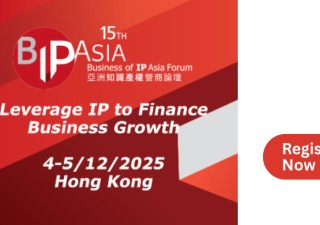The Debate of Drugs and Patents: A Modern Story of Life and Death
06 February 2018

Balancing consumer interests and rewards for entrepreneurial risk-taking and innovation have always been core to discussions on the patent system, and becomes an immediately emotive debate when the issue of public health is involved.
 As part of the Hong Kong University Law & Technology Centre’s Lecture in Intellectual Property series, the Right Honourable Professor Sir Robin Jacob gave a talk on the vital role patents play in the innovation and development of the life sciences industry, with the aim of spurring rational and practical discussions.
As part of the Hong Kong University Law & Technology Centre’s Lecture in Intellectual Property series, the Right Honourable Professor Sir Robin Jacob gave a talk on the vital role patents play in the innovation and development of the life sciences industry, with the aim of spurring rational and practical discussions.
Asia IP brings you highlights of the fascinating intellectual debate.
Waves of Criticisms
Sir Robin laid out some of the biggest faults anti-patent parties find in big pharma’s use of patents:
Prices are unnecessarily high. Many blame high drug prices on decades of patent protection that creates monopoly power for the patent holder as the sole manufacturer. Further, the effective protection may exceed that of the original patent as drug manufacturers engage in evergreening where minor amendments are made to the medicine so that it can be re-patented, according to a report by global awareness groups Global Justice Now and StopAids.
Others point to large marketing expenses by drug companies, believing there’s much room for lowering prices, if only a less protective patent system can put competition pressure on pharmaceutical companies to price drugs more fairly.
Lack of incentive for orphan drugs. Because market incentives are so prevalent under the current patent approach, there is little incentive for research in rare diseases and third world diseases, resulting in an increasing divide in public health among first and third world countries as medical breakthrough cater only to the rich who can afford high prices.
Parties pushing for change have largely argued for two options: delinking the price of medicines from the cost of research and instituting more stringent compulsory licensing.
Delinking the price of medicines from the cost of research has been raised in UN panels and international healthcare organizations like Unitaid, which propels new financing models for pharmaceutical research that reduce the relationship between R&D costs and the final price, especially in areas where market incentives are insufficient such as new antibiotics and tropical diseases.
Compulsory licensing is when a government allows a generic company to produce a patented drug without the consent of the patent owner, generally for use in the domestic market, by paying a royalty to the patent holder. This upholds the notion of promoting public health especially for leastdeveloped countries and countries that do not have production capacity, and is a flexibility allowed for in the World Trade Organization’s Trade-Related Aspects of Intellectual Property Rights Agreement.
The Counter-arguments
While Sir Robin doesn’t reject the plausibility of alternative financing models, he disagrees with many proposed changes to the patent system that seek to derail incentives by weakening patent protection. His research has shown that for a big pharma company, the R&D spend is around 20 percent of turnover from patented medicine, and the average development time of a new drug from 10-12 years means “protected medicines of today are paying for those of tomorrow.”
The price of a drug not only reflects investment in future R&D, but is also an incentive system tied to the great risks pharmaceutical companies take in developing a new drug. For example, shares in Eli Lilly fell by 13 percent when it announced two years ago the failure and cancellation of what it hoped to be a cure for Alzheimer’s. The company had invested over US$1 billion and 10 years of research, all evaporating overnight. These risks will not be palpable for researchers and investors if they were not compensated by great potential rewards, something the patent system helps materialize. He fears the current climate of debate has overlooked the complex economics in drug research, and doubts de-linkage and compulsory licensing adequately compensate risk takers for their research, thus having potentially detrimental impacts on new research and innovation.
Sir Robin further rebukes the claim that big pharma spends too much on promotion by pointing out that in most jurisdictions, save for the US, much of the drug promotion takes the form of sophisticated and educational programmes designed to educate medical professions about the new medicine, and is followed up by dialogue as to the drug’s adoption and impact in clinical use. It’s not “ordinary promotion to the general public – the Because You’re Worth It sort.”
And if the improvement is enough to matter, even if it’s as incremental an improvement as a variation that has somewhat better bioavailability or is a once instead of three-times-aday pill, “what is the matter with that?” asks Sir Robin. “Evergreening is a word of prejudice not rationality,” he believes, pointing out that the patent law will not allow for re-patenting of an old invention, and that while not all inventions are major steps, incremental improvements are important and warrant protection, too.
But affording new drugs such high level of market incentive is not without its faults. Sir Robin concurs that there is little commercial incentive to develop medicine for rare diseases and diseases that mostly afflicts the poor. Further, research for cures are also less incentivized, as Sir Robin points out that “antibiotic research is an example of the problem that if a medicine cures, you may not sell a lot of it”; there’s no coincidence research into finding new antibiotics has remained limited. The Gilead Hepatitis C treatment Sovaldi asks for a controversial US$84,000, he cites, in part because it’s not as profitable to price a cure like a daily medicine.
While some governments and medical doctors have protested this price as too expensive, Sir Robin counters that the cost of not-curing is higher, citing both personal and external costs of hospitalization, lost taxes and infection of the healthy as negative externalities that successful treatment eliminates. If the price is not “too expensive” from a social perspective but is for individuals, governments and the insurance system to realistically pay, more creative discussions may have to be sought to incentivize lowering of cost by pooling a large enough population to be treated. These are efforts that should happen on a national and even global level. The key, Sir Robin believes, is to provide incentives where it is lacking, instead of attacking the patent system in hopes to take away existing incentives for innovation.
How About Something More
“Offer a 30-year patent term for a major new antibiotic, or a cancer cure. And fix the prices of the patentee so that [the inventor] gets an ample reward,” Sir Jacob suggests as avenues to direct incentives to areas of major human affliction.
Assistant professor Ryan Whalen, a faculty member at the University of Hong Kong Faculty of Law and an expert in innovation policy and IP law, offers other examples of IP policy levers that are being used to drive innovation in specific areas. “State research funding can and is used to tailor research incentives. There are a number of countries with active programs aimed at increasing research into rare and ‘orphan’ diseases,” he says. Similarly, tailored incentives can be designed for particularly high-demand treatments – for example, new antibiotics. Incentives can range from as simple as providing prizes for successful innovation, such as longitude prizes offered by the British government to improve naval navigation, to more nuanced ways such as variable patent terms or price guarantees.
Moreover, governments can incentivize pharmaceutical companies to provide preferential pricing for developing markets by using technologically-enabled price discrimination. Currently, a concern among drug companies is that preferential pricing threatens to undercut global prices if the medicine is subsequently exported and re-sold in developed markets.
“We have recently seen patents granted for ‘smart pills’ that incorporate microprocessors and are able to better ensure that drugs are delivered to their intended recipients. These technologies have thus far been framed as tools to help reduce drug abuse, but they also have promise to enable more tailored discriminatory pricing. This could reduce concerns about re-exports and increase drug availability in developing economies,” says Whalen.
Ultimately, patents and other programmes that expand access carry the aim to spur innovation and ensure the fruits reach as many people as possible. As the debate continues, one mustn’t forget the premise of access rests first upon a continuous stream of innovation, and the mechanisms in place to guard them.
“Other cures are coming – cures for some cancers which work with a few injections and no chemo or radio therapy have recently come on the market. One day they may crack Alzheimer’s. Ask yourself what the world would pay for these before the event,” offers Sir Robin to a thoughtful crowd.






